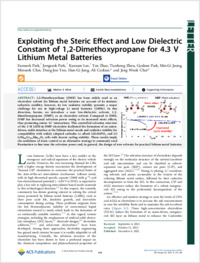Exploiting the Steric Effect and Low Dielectric Constant of 1,2-Dimethoxypropane for 4.3 V Lithium Metal Batteries
Université de Fribourg DOKPE
- Park, Eunseok ORCID Seoul National University
- Park, Jongseok Seoul National University
- Lee, Kyunam Seoul National University
- Zhao, Yan ORCID University of Fribourg
- Zhou, Tianhong ORCID University of Fribourg
- Park, Gyuleen Seoul National University
- Jeong, Min-Gi Korea Institute of Science and Technology (KIST)
- Choi, Minseok Seoul National University
- Yoo, Dong-Joo ORCID Korea University
- Jung, Hun-Gi ORCID Korea Institute of Science and Technology (KIST)
- Coskun, Ali ORCID University of Fribourg
- Choi, Jang Wook ORCID Seoul National University
- 04.12.2022
Published in:
- ACS Energy Letters. - American Chemical Society (ACS). - 2023, vol. 8, no. 1, p. 179-188
Materials Chemistry
Energy Engineering and Power Technology
Fuel Technology
Renewable Energy
Sustainability and the Environment
Chemistry (miscellaneous)
Electrochemical cells
Electrodes
Electrolytes
Solvation
Solvents
English
1,2-Dimethoxyethane (DME) has been widely used as an electrolyte solvent for lithium metal batteries on account of its intrinsic reductive stability; however, its low oxidative stability presents a major challenge for use in high-voltage Li metal batteries (LMBs). In this direction, herein, we introduce a new low-dielectric solvent, 1,2-dimethoxypropane (DMP), as an electrolyte solvent. Compared to DME, DMP has decreased solvation power owing to its increased steric effects, thus promoting anion–Li+ interactions. This controlled solvation structure of the 2 M LiFSI-in-DMP electrolyte facilitated the formation of an anion-driven, stable interface at the lithium metal anode and oxidative stability for compatibility with widely adopted cathodes to afford Li|LiFePO4 and Li|LiNi0.8Co0.1Mn0.1O2 cells with decent cycling stability. These results imply the usefulness of steric control as an alternative strategy to commonly used fluorination to fine-tune the solvation power and, in general, the design of new solvents for practical lithium metal batteries.
- Faculty
- Faculté des sciences et de médecine
- Department
- Département de Chimie
- Language
-
- English
- Classification
- Analytical chemistry
- License
-
Rights reserved
- Open access status
- bronze
- Identifiers
-
- DOI 10.1021/acsenergylett.2c02003
- ISSN 2380-8195
- Persistent URL
- https://folia.unifr.ch/global/documents/325196
Statistics
Document views: 157
File downloads:
- acsenergylett.2c02003: 495
